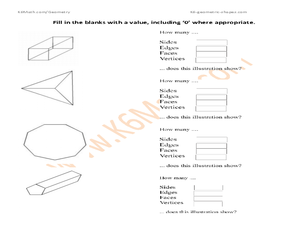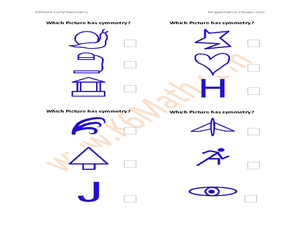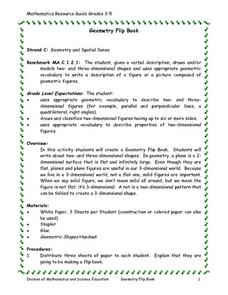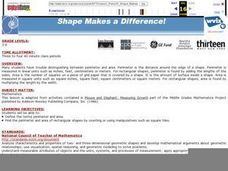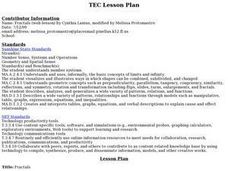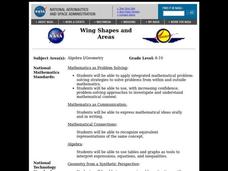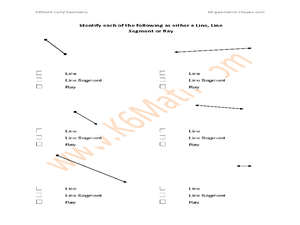Curated OER
How Many Sides, Faces, Vertices and Edges?
In this geometry worksheet, students determine the number of sides, faces, edges and vertices of given figures. A reference web site is given for additional activities.
Curated OER
Recognizing Symmetry
In this symmetry worksheet, learners determine whether given figures have symmetry, checking the correct one of a set. A reference web site is given for additional activities.
Curated OER
Calculating Area
In this area worksheet, students calculate the area of shaded figures shown on grids. A reference web site is given for additional activities
Curated OER
Calculate Volume and Surface Area
In this volume and surface area worksheet, students are given the volume of 4 figures and find the area. A web site reference is given for additional activities.
Curated OER
Interactivate - Lines, Rays, Line Segments, and Planes
Students explore lines, rays, line segments, and planes. In this math lesson, students discuss the math concepts and direct their instructor in graphing functions. Students collaborate in graphing additional functions.
Curated OER
Tessellations: Geometry and Symmetry
Students explore the concept of tessellations. In this tessellations lesson, students use an applet to construct tessellations. Students use regular polygons to construct tessellations. Students find patterns and symmetry in their...
Curated OER
Symmetry of Road Signs
Young scholars identify symmetry in road signs. In this geometry lesson, students explore objects in the real world for symmetry. They perform translation, rotation and reflection.
University of Nottingham
Drawing to Scale: A Garden
See how design and geometry go hand in hand. The activity asks learners to use geometry to design a backyard garden given dimensions of each feature. Scholars work with ratios and scale to develop an accurate scale drawing that includes...
Curriculum Corner
Academic Math Vocabulary
The ABCs of math are so important. Find commonly used math terms in a 42-page packet. Each page has the word, a place to write the definition, and a place to give specific examples of the term. A must-have for all math classrooms!
Noyce Foundation
Cubism
If cubism were a religion, would you follow it? Lower-level tasks focus primarily on counting the number cubes in a structure and relating the number to surface area. As learners progress to higher-level tasks, isometric drawings and...
Curated OER
Geometry Flip Book
Students investigate the concepts of geometry that can be grouped into a flip book that can be used for teaching and review purposes. They define the differences between two and three dimensional figures. Also polygons are reviewed and...
Curated OER
Tiling the Plane
Fifth graders use pattern blocks and triagular grid paper to reivew shape names, be introduced to the concept of a tiling of the plane, and determine which pattern blocks tile the plane. They are asked if they comprehend what a...
Curated OER
Patchwork Math
Students recognize and identify shapes in their environment. They investigate why objects can be composed of several different shapes. They follow a pattern to recreate designs using various shapes.
Curated OER
Incredible Edible Bridges
Students create a bridge using engineering and geometric concepts. In this geometry lesson, students identify the missing measures of polygons sides and angles. They work together to solve real life situation using problem solving...
Curated OER
Exploring Properties of Rectangular Prisms
Students explore the properties of rectangular prisms. In this geometry lesson, students identify properties of two and three dimensional shapes. They use Cabri technology to create polygons and solve problems.
Curated OER
Geography: Lengths, Perimeter, and Area of Similar Objects
Sixth graders explore characteristics of similar objects. Using attribute blocks, they explore the ratios of the perimeter, area and side length in similar shapes. They calculate and compare the area of shapes.
Curated OER
Exploring the Properties of Rectangular Prisms.
Students define properties of rectangular prisms. In this geometry lesson, students identify the relationship between two and three dimensional objects. They use Cabri technology to graph their figures.
Curated OER
Shape Makes a Difference!
Young scholars learn the difference between perimeter and area by watching a video and a hands on activity.
Curated OER
Faces, Vertices and Sides
In this geometry worksheet, students determine which shapes have more or less vertices, faces or sides. A reference web site is given for additional activities.
Curated OER
Vertices: More or Less?
For this vertices worksheet, students determine which figures have more or less vertices and name each figure. A reference web site is given for additional activities.
Math Mammoth
Circles
Your class examines a series of shapes and discusses how we know that they are not circles. In this way, you begin to acquaint them with the properties and parts of this geometric figure. Then, teach them how to use a protractor to...
Curated OER
What are Fractals?
Middle and high schoolers identify and analyze fractals and research information using the Internet to locate information about them. They look at fractals in relation to nature and other real world situations. Pupils create several...
Curated OER
Wing Shapes and Areas
Students, after reading the explanation given below, use FoilSim to determine the weight of the aircraft that can be lifted by a pair of wings of each type. They also design a unique platform of a wing to lift a plane weighing 11500 pounds.
Curated OER
Line, Line Segments and Rays
In this geometry worksheet, students identify items as either lines, line segments or rays by checking the appropriate box beneath each figure.


